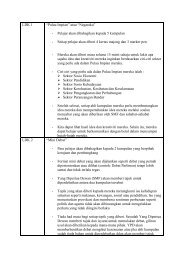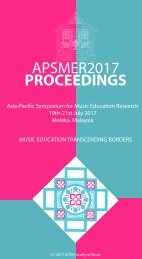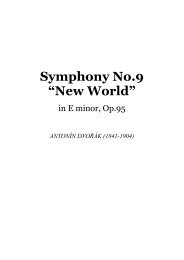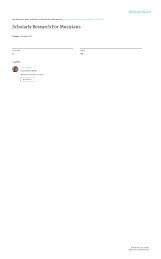APSMER2017 PROCEEDINGS
You also want an ePaper? Increase the reach of your titles
YUMPU automatically turns print PDFs into web optimized ePapers that Google loves.
!<br />
Proceedings of the 11th Asia-Pacific Symposium for Music Education Research<br />
(APSMER 2017) 19th to 21st July 2017, Melaka MALAYSIA<br />
!<br />
years much less after a year’s engagement and intervention but it is the<br />
first thing that has to be identified. The key question in a community<br />
engagement is, “what is your dream?” and “how can you realize that<br />
dream?” The logic model is the blue print which provides answers to<br />
questions, “what changes in the community does one want to see?” and<br />
“how can one achieve that change?”<br />
The ability to make music is the immediate end of music<br />
education but when music education is used as an intervention to<br />
empower a person or a community, it must inform and transform lives.<br />
The CMSL program envisions a community of persons whose lives are<br />
influenced by the discipline of music, touched by its beauty, and<br />
inspired by its perfection, with the hope of bringing back self-esteem<br />
and self-worth lost by extreme poverty. Only when this<br />
impoverishment is abated can society form good citizens.<br />
Figure 6: CMSL Program Logic Model<br />
Figures 7, 8 and 9 show the development of the CMSL in 3<br />
years. Each year has a designated color so as to easily identify which<br />
ones were realized and what changes occurred in each year. The<br />
development of CMSL in 2013 shows that the children were able to<br />
perform in the recital. The music learning was primarily by rote, i.e.<br />
the use of chords for guitar and keyboard and largely dependent on<br />
hearing not reading music.<br />
!<br />
!<br />
!<br />
21<br />
!








